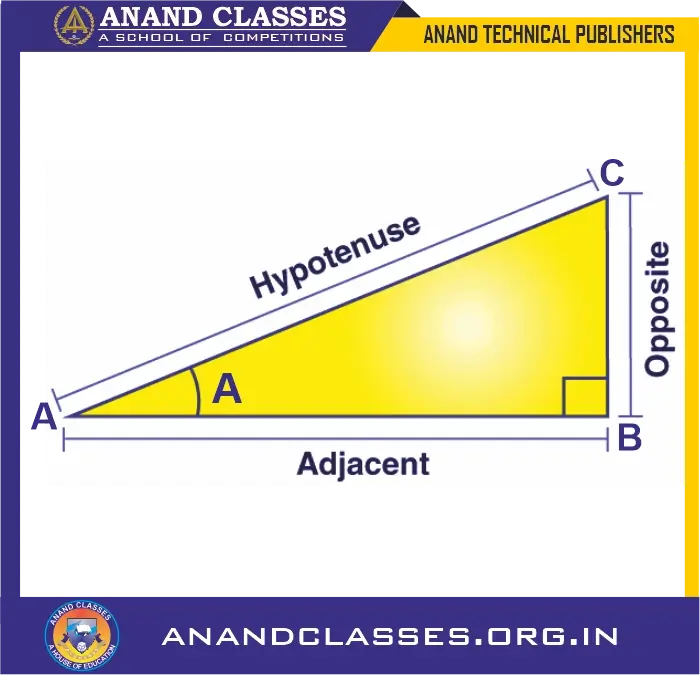ANAND CLASSES Study Material and Notes to learn Class 10 Trigonometric Ratios with clear definitions, formulas, and identities. Perfect for CBSE Class 10 & competitive exams JEE, NDA.
[related_inline_dropdown]
📚 Basic Concepts of Trigonometry
🔹 What is Trigonometry?
Trigonometry is the branch of mathematics that deals with relationships between angles and sides of a triangle.
The word comes from:
- ‘tri’ – meaning three
- ‘gon’ – meaning sides
- ‘metron’ – meaning measure
It originated from the need to compute distances in astronomy and is now widely used in physics, engineering, and navigation.
🔹 What are Trigonometric Ratios?
Trigonometric ratios relate the angles of a right triangle to the lengths of its sides.
Consider a right triangle ABC, right-angled at B:
- AC: hypotenuse
- BC: side opposite to angle A (called perpendicular)
- AB: side adjacent to angle A (called base)

The six trigonometric ratios for angle A are defined as:
$$\sin A = \frac{\text{side opposite to angle } A}{\text{hypotenuse}} = \frac{BC}{AC}$$
$$\cos A = \frac{\text{side adjacent to angle } A}{\text{hypotenuse}} = \frac{AB}{AC} $$
$$\tan A = \frac{\text{side opposite to angle } A}{\text{side adjacent to angle } A} = \frac{BC}{AB} $$
$$\cot A = \frac{\text{side adjacent to angle } A}{\text{side opposite to angle } A} = \frac{AB}{BC}$$
$$\sec A = \frac{\text{hypotenuse}}{\text{side adjacent to angle } A} = \frac{AC}{AB}$$
$$\mathrm{cosec}\;A = \frac{\text{hypotenuse}}{\text{side opposite to angle } A} = \frac{AC}{BC}$$
🔄 Relationship between Trigonometric Ratios
🔸 Reciprocal Identities
Each ratio has a reciprocal:
Identity.1 :
$$\sin A \cdot \mathrm{cosec}\;A = \frac{BC}{AC} \cdot \frac{AC}{BC} = 1 \quad $$
$$ \quad \sin A = \frac{1}{\mathrm{cosec}\;A}, \quad \mathrm{cosec}\;A = \frac{1}{\sin A}$$
Identity.2 :
$$\cos A \cdot \sec A = \frac{AB}{AC} \cdot \frac{AC}{AB} = 1 \quad $$
$$\quad \cos A = \frac{1}{\sec A}, \quad \sec A = \frac{1}{\cos A}$$
Identity.3 :
$$\tan A \cdot \cot A = \frac{BC}{AB} \cdot \frac{AB}{BC} = 1 \quad$$
$$ \quad \tan A = \frac{1}{\cot A}, \quad \cot A = \frac{1}{\tan A}$$
🔸 Pythagorean Identities
Using the Pythagorean Theorem: $$BC^2 + AB^2 = AC^2$$
$$\sin^2 A + \cos^2 A = \frac{BC^2}{AC^2} + \frac{AB^2}{AC^2} = \frac{BC^2 + AB^2}{AC^2} = \frac{AC^2}{AC^2} = 1$$
$$\sec^2 A – \tan^2 A = \frac{AC^2}{AB^2} – \frac{BC^2}{AB^2} = \frac{AC^2 – BC^2}{AB^2} = \frac{AB^2}{AB^2} = 1$$
$$\mathrm{cosec}^2 A – \cot^2 A = \frac{AC^2}{BC^2} – \frac{AB^2}{BC^2} = \frac{AC^2 – AB^2}{BC^2} = \frac{BC^2}{BC^2} = 1$$
🔸 Alternate Forms of Identities
From the above identities, we get:
$$\sin^2 A = 1 – \cos^2 A \quad ; \quad \cos^2 A = 1 – \sin^2 A$$
$$\sec^2 A = 1 + \tan^2 A \quad ; \quad \tan^2 A = \sec^2 A – 1$$
$$\mathrm{cosec}^2 A = 1 + \cot^2 A \quad ; \quad \cot^2 A = \mathrm{cosec}^2 A – 1$$
✅ Quotient Trigonometric Identities:
Using the basic definitions of sine and cosine:
$$tan A = \dfrac{\sin A}{\cos A}$$
$$\cot A = \dfrac{\cos A}{\sin A}$$
These are derived from the ratios:
$$\sin A = \dfrac{\text{side opposite to angle } A}{\text{hypotenuse}}$$
$$\cos A = \dfrac{\text{side adjacent to angle } A}{\text{hypotenuse}}$$
So when we divide:
$$\tan A = \dfrac{\sin A}{\cos A} = \dfrac{\dfrac{\text{opposite}}{\text{hypotenuse}}}{\dfrac{\text{adjacent}}{\text{hypotenuse}}} = \dfrac{\text{opposite}}{\text{adjacent}}$$
Similarly: $$\cot A = \dfrac{\cos A}{\sin A} = \dfrac{\dfrac{\text{adjacent}}{\text{hypotenuse}}}{\dfrac{\text{opposite}}{\text{hypotenuse}}} = \dfrac{\text{adjacent}}{\text{opposite}}$$
Formulas of Basic Trigonometric Ratios
The formulas of these basic trigonometric ratios are listed below:
- Sin θ = Perpendicular / Hypotenuse
- Cos θ = Base / Hypotenuse
- Tan θ = Sin θ / Cos θ = Perpendicular / Base
- Cosec θ = 1 / Sin θ = Hypotenuse / Perpendicular
- Sec θ = 1 / Cos θ = Hypotenuse / Base
- Cot θ = 1 / Tan θ = Base / Perpendicular
List of All Trigonometric Identities
The three basic trigonometric identities are listed below:
- sin2θ + cos2θ = 1
- 1 + tan2θ = sec2θ
- 1 + cot2θ = cosec2θ
Some Other Trigonometric Identities
Reciprocal Identities
- cosec θ = 1/sin θ
- sec θ = 1/cos θ
- cot θ = 1/tan θ
Quotient Identities
- tan θ = sin θ/cos θ
- cot θ = cos θ/sin θ
Trigonmetric Identities Table Summary
| Identities Name | Identities |
|---|---|
| Pythagorean Identities | sin2θ + cos2θ = 1 |
| 1 + tan2θ = sec2θ | |
| 1 + cot2θ = cosec2θ | |
| Reciprocal Identities | cosec θ = 1/sin θ |
| sec θ = 1/cos θ | |
| cot θ = 1/tan θ | |
| Quotient Identities | tan θ = sin θ/cos θ |
| cot θ = cos θ/sin θ |
Solved Examples on Trigonometric Identities for Class 10
Example 1: Prove that: (1 + cot2A) sin2A = 1
Solution:
LHS = (1 + cot2A) sin2A
Using trigonometric identity
1 + cot2θ = cosec2θ
⇒ LHS = cosec2A sin2A
⇒ LHS = (1 / sin2A) sin2A [cosec A = 1 / sin A]
⇒ LHS = 1
Thus, LHS = RHS
Hence Proved
Example 2: Prove that: tan2B cos2B = 1 – cos2B
Solution:
LHS = tan2B cos2B
Using trigonometric identity
⇒ 1 + tan2θ = sec2θ
⇒ tan2θ = sec2θ – 1
⇒ LHS = (sec2B – 1) cos2B
⇒ LHS = sec2Bcos2B – cos2B
⇒ LHS = [(1/ cos2B)cos2B] – cos2B
⇒ LHS = 1 – cos2B
Thus, LHS = RHS
Hence Proved
Example 3: Prove that: tan θ + (1/tan θ) = sec θ cosec θ
Solution:
LHS = tan θ + (1/tan θ)
⇒ LHS = (tan2θ + 1)/tan θ
Using trigonometric identity
1 + tan2θ = sec2θ
⇒ LHS = sec2θ/tanθ
⇒ LHS = (1 / cos2θ) × (cos θ / sinθ )
⇒ LHS = (1 / cos θ) × (1 / sin θ)
⇒ LHS = sec θ cosec θ [sec θ = 1/cos θ and cosec θ = 1/sin θ]
Thus, LHS = RHS
Hence Proved
Example 4: Prove that: √[(1 – cos θ)/(1 + cos θ)] = cosec θ – cot θ
Solution:
LHS = √[(1 – cos θ)/(1 + cos θ)]
⇒ LHS = √[{(1 – cos θ)/(1 + cos θ)} × {(1 – cos θ) / (1 – cos θ)}]
⇒ LHS = √[(1 – cos θ)2/(1 – cos2θ)]
Using trigonometric identity
sin2θ + cos2θ = 1
⇒ LHS = √[(1 – cosθ)2 / sin2θ]
⇒ LHS = (1 – cos θ) / sin θ
⇒ LHS = (1 / sin θ) – (cos θ / sin θ)
⇒ LHS = cosec θ – cot θ [cotθ = cosθ / sinθ and cosecθ = 1/sinθ]
Thus, LHS = RHS
Hence Proved
Example 5: Prove that: sin θ / (1 – cos θ) = cosec θ + cot θ
Solution:
LHS = sin θ/(1 – cos θ)
⇒ LHS = [sin θ/(1 – cos θ)] × [(1 + cos θ)/(1 + cos θ)}]
⇒ LHS = [sin θ (1 + cos θ)] / (1 – cos2θ)
Using trigonometric identity
sin2θ + cos2θ = 1
⇒ LHS = [sin θ (1 + cos θ)] / sin2θ
⇒ LHS = (1 + cos θ)/sin θ
⇒ LHS = (1 / sin θ) + (cos θ/sinθ)
⇒ LHS = cosec θ + cot θ [cot θ = cos θ/sin θ and cosec θ = 1/sin θ]
Thus, LHS = RHS
Hence Proved
Example 6: Prove that: [(1 + cot2θ)tan θ]/sec2θ = cot θ
Solution:
LHS = [(1 + cot2θ)tan θ]/sec2θ
Using trigonometric identity
1 + cot2θ = cosec2θ
⇒ LHS = [cosec2θ tan θ]/sec2θ
⇒ LHS = (1/sin2θ) × (sin θ/cos θ) × (cos2θ/1)
⇒ LHS = (cos θ/ sin θ)
⇒ LHS = cot θ [cot θ = cos θ/sinθ]
Thus, LHS = RHS
Hence Proved
Practice Questions on Trigonometric Identities Class 10
Q1: Prove that: cosecθ√[(1 – cos2θ) = 1
Q2: Prove that: (sec2x – 1)(cosec2x – 1) = 1
Q3: Prove that: sin2C + [1 / (1 + tan2C)] = 1
Q4: Prove that: sec A (1 – sin A) (sec A + tan A) = 1
Q5: Prove that: (1 – sin θ) / (1 + sin θ) = (sec θ – tanθ)2
Q6: Prove that: (cosec θ + sin θ)(cosec θ – sin θ) = cot2θ + cos2θ
Here is a clear and organized explanation of Frequently Asked Questions (FAQs) on Trigonometry — perfect for academic use or adding to your educational platform like ANAND CLASSES:
Frequently Asked Questions (FAQs) on Trigonometry
Q1. What do you mean by Trigonometry?
Answer:
Trigonometry is a branch of mathematics that studies the relationship between the angles and sides of right-angled triangles. It is mainly used to find unknown values using known ratios of sides and angles.
It involves six trigonometric functions that define these relationships.
➡️ Learn more at https://anandclasses.co.in/
Q2. What are the six basic Trigonometric Functions?
Answer:
The six basic trigonometric functions are:
- Sine (sin)
- Cosine (cos)
- Tangent (tan)
- Cosecant (cosec)
- Secant (sec)
- Cotangent (cot)
These functions are based on the sides of a right triangle and are used to compute angles or lengths in geometric problems.
Q3. What is the formula for six trigonometric functions?
Answer:
In a right-angled triangle with angle A:
$$\sin A = \dfrac{\text{Opposite side}}{\text{Hypotenuse}}$$
$$\cos A = \dfrac{\text{Adjacent side}}{\text{Hypotenuse}}$$
$$\tan A = \dfrac{\text{Opposite side}}{\text{Adjacent side}}$$
$$\cot A = \dfrac{\text{Adjacent side}}{\text{Opposite side}}$$
$$\sec A = \dfrac{\text{Hypotenuse}}{\text{Adjacent side}}$$
$$\mathrm{cosec}\;A = \dfrac{\text{Hypotenuse}}{\text{Opposite side}}$$
These formulas are fundamental in solving trigonometric problems.
Q4. What is the primary function of trigonometry?
Answer:
The three primary trigonometric functions are:
- Sine (sin)
- Cosine (cos)
- Tangent (tan)
All other trigonometric functions can be derived from these three. They form the foundation of trigonometry.
Q5. Who is the founder of trigonometry?
Answer:
Hipparchus, a Greek astronomer, geographer, and mathematician, is credited with discovering the early concepts of trigonometry around 150 B.C. He compiled the first known trigonometric table.
Q6. What are the Applications of Trigonometry in Real Life?
Answer:
Trigonometry has numerous real-world applications, including:
- Measuring Heights and Distances (e.g., mountains, towers)
- Aviation and Aeronautics
- Navigation (Air and Sea)
- Criminology (e.g., determining trajectories)
- Engineering and Architecture
- Marine Biology
These fields use trigonometric calculations to solve practical problems involving angles and measurements.
✅ MCQs on Trigonometry with Answers & Explanations
Q1. Which of the following is NOT a trigonometric function?
A. Sine
B. Cosine
C. Logarithm
D. Tangent
Answer: ✅ C. Logarithm
Explanation: Logarithm is a mathematical function but not a trigonometric one. Trigonometric functions include sine, cosine, tangent, etc.
Q2. If $\sin A = \dfrac{3}{5}$, and A is an acute angle, what is the value of cos A?
A. $\dfrac{4}{5}$
B. $\dfrac{5}{3}$
C. $\dfrac{3}{4}$
D. $\dfrac{4}{3}$
Answer: ✅ A. $\dfrac{4}{5}$
Explanation:
Use identity:
$$\sin^2 A + \cos^2 A = 1 $$
$$\left( \dfrac{3}{5} \right)^2 + \cos^2 A = 1 \Rightarrow \cos^2 A = 1 – \dfrac{9}{25} = \dfrac{16}{25} \Rightarrow \cos A = \dfrac{4}{5}$$
Q3. What is the value of $\tan 45^\circ$?
A. 0
B. 1
C. $\sqrt{3}$
D. Not defined
Answer: ✅ B. 1
Explanation:
At $45^\circ$, the opposite and adjacent sides of a right triangle are equal. Hence,
$\tan 45^\circ = \dfrac{\text{Opposite}}{\text{Adjacent}} = 1$
Q4. If $\cot A = \dfrac{1}{\sqrt{3}}$, then what is the value of A?
A. $30^\circ$
B. $45^\circ$
C. $60^\circ$
D. $90^\circ$
Answer: ✅ C. $60^\circ$
Explanation:
We know $\cot 60^\circ = \dfrac{1}{\sqrt{3}}$, so $A = 60^\circ$
Q5. Which of the following is the correct value of $\mathrm{cosec}\;30^\circ$?
A. 1
B. 2
C. 2\sqrt{2}
D. 232\sqrt{3}
Answer: ✅ B. 2
Explanation: $\mathrm{cosec}\;30^\circ = \dfrac{1}{\sin 30^\circ} = \dfrac{1}{1/2} = 2$
Q6. Which identity is always true for all values of angle θ\theta?
A. $\sin^2 \theta + \cos^2 \theta = 1$
B. $\tan \theta + \cot \theta = 1$
C. $\sec \theta + \mathrm{cosec} \theta = 1$
D. $\tan^2 \theta = \cot^2 \theta$
Answer: ✅ A. $\sin^2 \theta + \cos^2 \theta = 1$
Explanation: This is the fundamental Pythagorean identity in trigonometry.
Q7. If $\tan A = 1$, then the value of A is—
A. $30^\circ$
B. $45^\circ$
C. $60^\circ$
D. $90^\circ$
Answer: ✅ B. $45^\circ$
Explanation: $\tan 45^\circ$ = 1, hence A = $45^\circ$
🧠 “Do You Know?” Facts about Trigonometry
🔹 The word “Trigonometry” comes from Greek.
It is derived from the Greek words “trigonon” (triangle) and “metron” (measure), meaning “measuring triangles.”
🔹 Trigonometry was originally developed for astronomy.
Ancient astronomers used trigonometric concepts to study the motion of celestial bodies and map the night sky.
🔹 Right-angled triangles are the base of all trigonometric studies.
Even complex applications in calculus and physics often trace back to the simple ratios found in right triangles.
🔹 Sine and Cosine functions form the basis of sound waves and signals.
These functions are used in music, electronics, and communication systems like mobile phones and radios.
🔹 The first trigonometric table was created over 2000 years ago.
Hipparchus created a chord table, which is considered the earliest form of a trigonometric table.
🔹 Your GPS uses trigonometry!
Global Positioning Systems (GPS) rely on the principles of trigonometry to calculate positions and distances based on satellite signals.
🔹 Trigonometry helps build roller coasters!
Engineers use it to design the slopes, curves, and loops for thrilling rides with accurate safety measures.
🔹 Bees unknowingly use trigonometry!
The hexagonal shape of honeycombs, which involves precise angles, is a result of natural optimization — a concept deeply connected to geometry and trigonometry.
🔹 Trigonometry is essential in video game design.
From the way characters move to how shadows are cast — trigonometric calculations power a lot of the visual realism in gaming.


